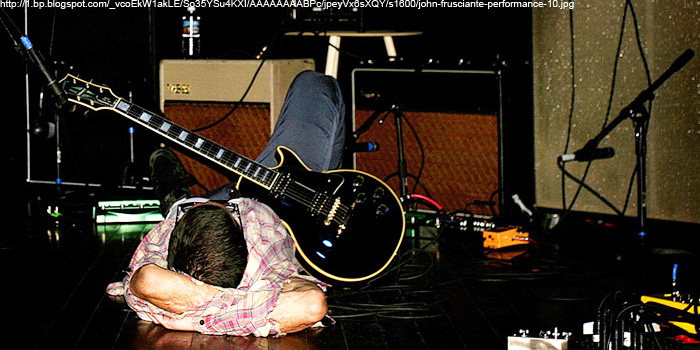
"When the intellectual part of guitar playing overrides the spiritual, you don't get to extreme heights."
- John Frusciante to Rolling Stone Magazine, February 2007
If it was not for John Frusciante, I would not be playing guitar today. Initially, I was intrigued by his back-up vocal work as well as the tone and sparseness of his guitar playing. An overwhelming sense of conflict is instilled in his music. He was the first musician that I immediately had to research because hearing him gives such a clear window to a life plagued with trauma.
My earliest memories of him are from fifth grade, hearing the bouncy riff of "Scar Tissue" transmit over the FM waves as my mom drove me to swim practice. At a time when drop-tuned, distorted guitar playing and binge-note solos were overabundant, Frusciante uncompromisingly stood a stark minimalist. I distinctly remember the way his backup vocal on the chorus floated amidst Anthony Kiedis and suddenly swept in like an angel on the word "lonely" to overwhelm and impart. I had no idea how it worked, or why I couldn't get it out of my head. It was an ominous cry for help, an SOS. I thought he had discovered a secret of harmonizing that no one else knew, how could a human sound like that? I vividly remember the tone on the last solo of the maple necked 1957 Stratocaster as it connected dots in the night time sky and left you standing amongst countless miles of barren wasteland with nothing but the taste of the dry, sandy air on your tongue and the smell of desperation in the air.
In the words of Isaac Newton, "If I have been able to see further, it was only because I was standing on the shoulders of giants." I am very grateful to have John Frusciante as such a significant figure and influence in my life. Not only is he just a musician, but he is a visionary. He embodies a steadfast set of beliefs manifested spiritually and has a knowledge of analog recording techniques that may be taken to the grave.I mean, the guy clinically died once, lost all his teeth, had to have facial reconstructive surgery, almost had to have his arms amputated and came back from it to record the best music of his caree. His music saved his life. He won't be found in the tabloids or the Hollywood grind despite being in one of the most commercially successful rock bands of all time, but he will be found in his home studio devoting all of his time to what he loves. In 2004, he released six full length solo albums each exploring different genres and recordingtechniques all on his own.I will hold everything he has taught me in the highest regard
Introduction Jams
Possibly, the most profound performances of John Frusciante are during the improvisational introduction jams performed by the band prior to each concert. This particular concert was held in a small theater in Hollywood on May 5th, 2007 for the Silverlake Music Conservatory. The Silverlake Music Conservatory is a non-profit music education school for underprivliged children pioneered by Flea to make up for the lack of funding for arts education in the Los Angeles area. Frusciante has stated that he "often accredits the variability of one performance to the next to the crowd and the energy he draws from them." in The Heart Is a Drum Machine by Christopher Pomerenke. Needless to say, Frusciante must have found walking out to a stage of awestruck children particularly inspiring.
The various elements that influence Frusciante's playing are summed up well in this jam. The jam initially begins with a very rhythmic and funky lead with the use of the Ibanez WH-10 wah pedal very remiscent to the intro of Jimi Hendrix's "Voodoo Child". The performance then segways into a percussive and minimalistic groove making use of many cat-like glissandos before erupting into a fury of screaming beat frequency notes via unison bends. Frusciante articulates the climax of the improvisation physically, by moving in eradic fashions corresponding to the sounds. After Frusciante composes himself and grabs a new pick (3:20), he unleashes blended flurry of notes rendered with the Ibanez WH-10 into an indiscernible language. It ends with Frusciante disengaging the wah pedal with a violent kick as Chad Smith (drummer) queues the last note, and immediately walking off stage.
TONE: Boss DS-2 Turbo Distortion, Ibanez WH-10
Californication
Most Notable Performance 8:15 - 9:09
Stylistically, the "Californication" solo is minimalist and relies on few ringing notes to establish melodies. Techniques such as bends in measures 81 and 83 stand in contrast with the preceding drone notes and are given new life. The style prominent throughout most of "Californication" is extremely minimalistic; It depends more on appropriate note placement swimming in complex bass lines. Before recording "Californication", he took a 6 year hiatus for rehabilitation. During his time off, Frusciante had not been playing guitar as opposed to his usual 5-6 hour a day practice, but instead painted. While recording this album, Frusciante lacked the strength to play guitar in a similar style to what's on "Blood Sugar Sex Magik", and instead approached the guitar as more of a composer and carefully decided exactly where to place notes to provoke the most dramatic emotional response.
The "Californication" guitar solo has seen more experimentation over the years than any other. While early improvisations of this solo involved minimalistic melodies played on the Gretsch White Falcon, later renditions around 2006 saw the use of a stratocaster, distortions, and the Ibanez WH-10 Wah pedal.
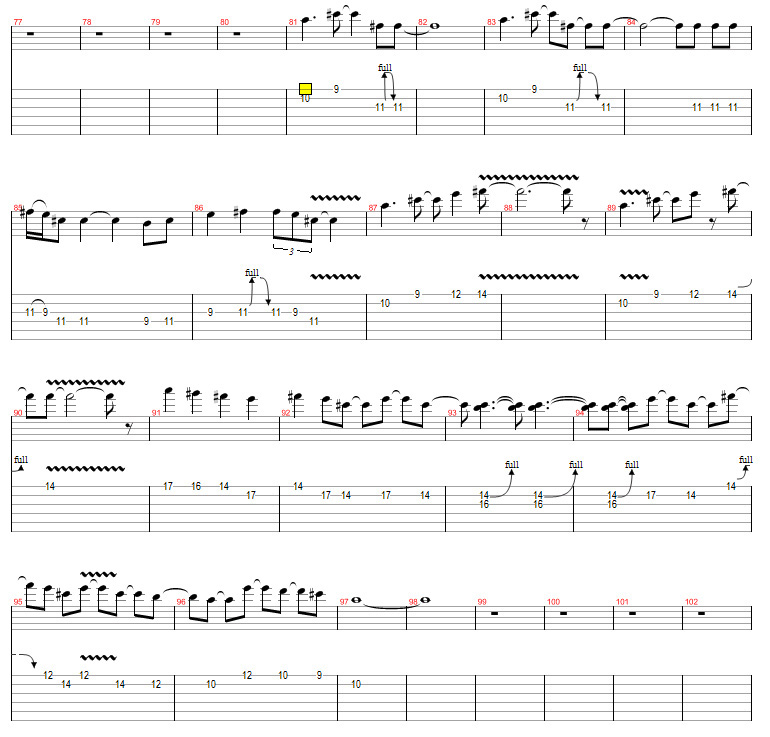
TONE: Gretsch White Falcon / Fender Stratocaster, Boss DS-2 Turbo Distortion, Ibanez WH-10 wah
Don't Forget Me
Most Notable Performance 6:06 - 7:30
Theoretically, this solo is based in A minor. During the solo, Flea follows the A - F - B# - G octave slap bass line while Frusciante begins by arpeggiating descending triads in an Am - G - Am - F pattern before breaking out into a more improvisational passage in A minor by repeating descending 32nd note phrases. These triads, generally formed on the EBG or BGD strings are a staple of Frusciante's improvisation, often using them to bridge the gap between a chordal melody and a lead as demonstrated here.
Stylistically, the "Don't Forget Me" solos tend to be the most psychedelic sounding of all Fusciante's improvisations. Often employed are the Moog MuRF, the Boss Chorus Ensemble, the Ibanez WH-10, and various delays. Fusciante can often be seen toggling the settings of his Moog MuRF pedal before this specific solo.
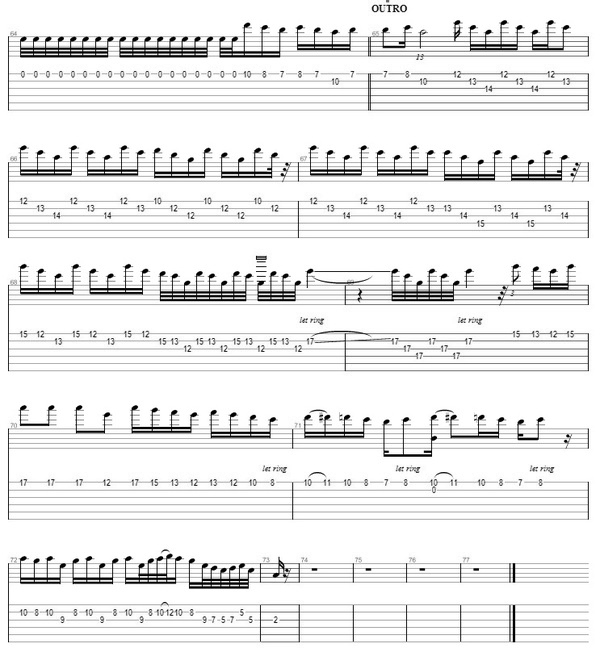
TONE: Moog MuRF, Boss Chorus Ensemble, Ibanez WH-10, Line 6 DL-4
Scar Tissue
Most Notable Performance 6:04-6:50
Theoretically, this solo is in D minor and uses very few, well spaced notes. One of the more interesting aspects of John and Flea's playing is that you often find more complexity rhythmically while the guitar makes a statement through tone and note placement. Flea begins the first two measures by playing a perfect unison of D on the G string and the open D string before sliding back to C to harmonize with the D string. He then plays similar two-note inventions to Frusciante's main riff for two measures. The former is being performed while John slides a tense G on the 20th fret to a A and then back down to E. This is a case where Flea begins by descending and John begins by ascending, both balancing the other rhythmically. This technique is used often on the solos and shows a great constrast and struggle between the rhythm and the lead for dominance, similar to some of Eric Clapton's improvisations with Cream.
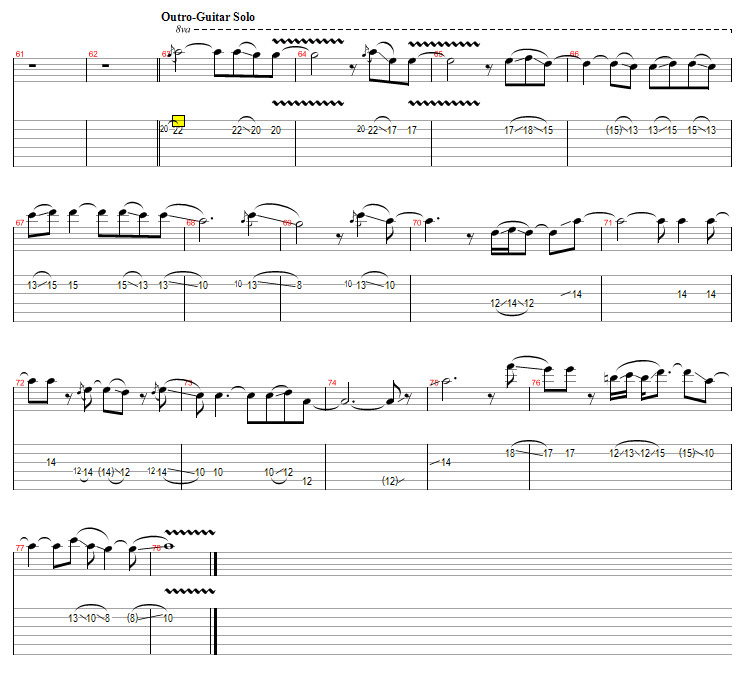
TONE: Boss DS-2 distortion, Ibanez WH-10 wah
Dani California
Theoretically, "Dani California" is in the key of A harmonic minor and draws heavily on the flatted sixth. It is a Stadium Arcadium era solo that shows a profound influence from Jimi Hendrix, as does much of his playing on that album. The quick glissando and passages in measures 94, 96, 98, 101, 103 and 105 establish the main melody to the root and shows an A - C - F note ascension before returning back to around the first fret to play a lower contrasting phrase. The repetition of the descending D - C - A notes in measure 100 are phrased reminiscent of Eric Clapton during his days with Cream.
Stylistically, the "Dani California" solo is also very influenced by Jimi Hendrix. It features the use of the Electro-Harmonix English Muff'n fuzz pedal in a very bassy tone. Towards the end of the solo, Frusciante engages the Ibanez WH-10 wah pedal and blends an arpeggiation of notes together using multiple unison bends. this continuous screetching "cat" language is his stylistic fingerprint and draws very much from early funk innovators, such as Eddie Hazel of Funkadelic.
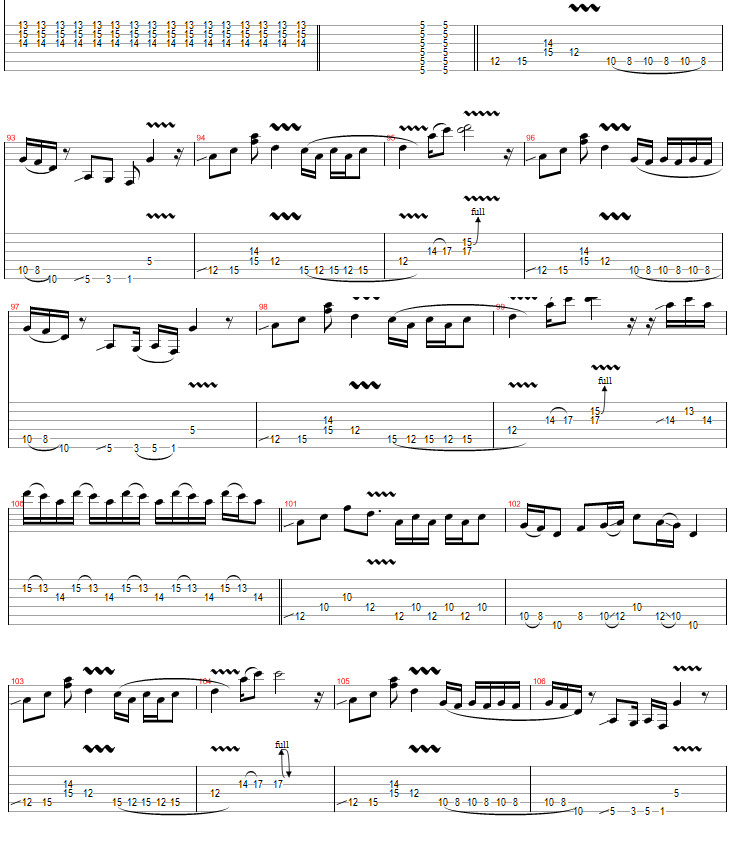
TONE: Fender Stratocaster, Electro-Harmonix English Muff'n, Ibanez WH-10 wah pedal
Throw Away Your Television
The "Throw Away Your Television" outros are in the key of A minor. The bass line played behind the guitar lead follows an A - G - F groove of 16th notes. Beat frequencies are widely used to emulate a "scream" sound. Frusciante generally begins the improvisation by climbing the A Pentatonic Minor scale on the B string while bending the pitch of the G string into unison. Throughout these solos, Frusciante paints grids of quick 32nd note modules and connects them together to forge some melody, although these solos have more textural characteristics.
TONE: Boss DS-2 Turbo Distortion
Sources
"John Frusciante." Wikipedia, The Free Encyclopedia. Wikimedia Foundation, Web. 8 May. 2011.
Cover Image: http://i103.photobucket.com/albums/m129/galacticmime/juliacher0zu.jpg
All tablatures provided by www.ultimate-guitar.com
I am not the original owner of any of the youtube videos presented
Cover Image: http://i103.photobucket.com/albums/m129/galacticmime/juliacher0zu.jpg
All tablatures provided by www.ultimate-guitar.com
I am not the original owner of any of the youtube videos presented

